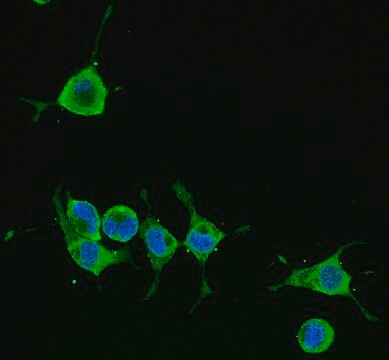MAB348-AF647
Anti-APP A4, a.a. 66-81 of APP {NT} Antibody, clone 22C11, Alexa Fluor™ 647 Conjugate
clone 22C11, from mouse, ALEXA FLUOR™ 647
동의어(들):
Amyloid beta A4 protein, ABPP, Alzheimer disease amyloid protein, Amyloid precursor protein, APP, APPI, Cerebral vascular amyloid peptide, CVAP, PN-II, PreA4, Protease nexin-II, PN-II, N-APP, Soluble APP-alpha, S-APP-alpha, Soluble APP-beta, S-APP-beta,
About This Item
추천 제품
생물학적 소스
mouse
Quality Level
결합
ALEXA FLUOR™ 647
항체 형태
purified antibody
항체 생산 유형
primary antibodies
클론
22C11, monoclonal
종 반응성
canine, porcine, rat, fish, human, monkey, mouse
기술
immunocytochemistry: suitable
동형
IgG1
NCBI 수납 번호
UniProt 수납 번호
배송 상태
wet ice
타겟 번역 후 변형
unmodified
유전자 정보
human ... APP(351)
일반 설명
애플리케이션
품질
Immunocytochemistry Analysis: A 1:100 dilution of this antibody detected APP A4 in SH-SY5Y cells.
표적 설명
기타 정보
법적 정보
Not finding the right product?
Try our 제품 선택기 도구.
Storage Class Code
12 - Non Combustible Liquids
WGK
WGK 2
Flash Point (°F)
Not applicable
Flash Point (°C)
Not applicable
시험 성적서(COA)
제품의 로트/배치 번호를 입력하여 시험 성적서(COA)을 검색하십시오. 로트 및 배치 번호는 제품 라벨에 있는 ‘로트’ 또는 ‘배치’라는 용어 뒤에서 찾을 수 있습니다.
자사의 과학자팀은 생명 과학, 재료 과학, 화학 합성, 크로마토그래피, 분석 및 기타 많은 영역을 포함한 모든 과학 분야에 경험이 있습니다..
고객지원팀으로 연락바랍니다.







